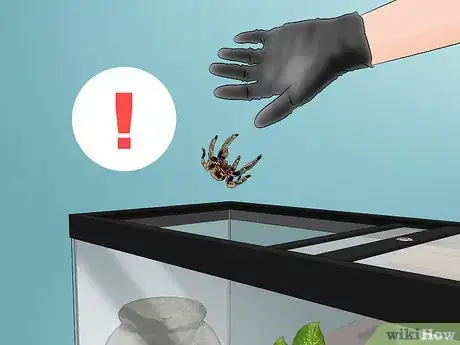This article was co-authored by Deanne Pawlisch, CVT, MA. Deanne Pawlisch is a Certified Veterinary Technician, who does corporate training for veterinary practices and has taught at the NAVTA-approved Veterinary Assistant Program at the Harper College in Illinois and in 2011 was elected to the board of the Veterinary Emergency and Critical Care Foundation. Deanne has been a Board Member of the Veterinary Emergency and Critical Care Foundation in San Antonio, Texas since 2011. She holds a BS in Anthropology from Loyola University and an MA in Anthropology from Northern Illinois University.
There are 7 references cited in this article, which can be found at the bottom of the page.
wikiHow marks an article as reader-approved once it receives enough positive feedback. In this case, 87% of readers who voted found the article helpful, earning it our reader-approved status.
This article has been viewed 409,052 times.
Tarantulas, while often given a bad reputation in films, are actually fascinating animals and make interesting pets. They are a popular choice of pet arachnid, have a calm disposition, and are large and fun to watch as they roam through their environment. If this is your first time owning a pet tarantula, you need to know that there are various species to choose from. You'll have to consider your resources, experience level, and environment when choosing a pet tarantula.
Steps
Selecting a Tarantula Breed
-
1Evaluate your experience level with tarantulas. If you have never owned a tarantula before, or if you owned one for only a month or two, consider yourself a beginner. On the other hand, if you’re already familiar with various breeds of tarantula, have owned one or more tarantula for years, and are prepared to invest time and money in your arachnid pet, you’re likely ready to own a more challenging breed.[1]
- If you’re a beginner tarantula owner and purchase a breed that's difficult to care for, you'll likely end up not enjoying your pet.
- Begin by doing your research on different types and their habits. The Tarantula Keeper's Guild book is a great place to start if you're interested in learning more about tarantulas before you make your first purchase.
- Some tarantulas are arboreal, which means they are tree dwelling, while non-arboreal tarantulas are ground-dwelling or burrowers. Some non-arboreal tarantulas will be out in the open where you can enjoy watching them, while others prefer to hide. This can be disappointing for some first-time tarantula owners who hope to enjoy watching their new pet.
- Consider the time, money and dedication caring for a new animal takes. Each type has different enclosure styles, food and feeding requirements, and temperature and humidity requirements. Also, some tarantulas can live up to 30+ years and grow very slowly. Some baby slings can take years to grow to a few inches in size.
-
2Choose a beginner breed if you’re a first-time owner. Species like the Common Pink Toe (Avicularia Avicularia), Costa Rican Stripe Knee (Aphonopelma Seemanni), Chilean Rose (Grammostola Rosea), Curly Hair (Brachypelma Albopilosum), Mexican Redknee Tarantula (Brachypelma Smithi), and several other members of the Brachyphelma family are great starter species. [2]
- These tarantula breeds are fairly docile and don't require special attention. They are not exceptionally large, and will be unlikely to bite you.
Advertisement -
3Choose a more advanced breed if you’ve owned tarantulas before. If you have experience caring for tarantulas, you can purchase a breed that requires more intensive care. Some of the more interesting tarantulas require past experience with tarantulas, but can have a lot of show quality.[3]
- Species such as the Goliath Birdeater (Theraphosa Blondi), Cobalt Blue (Haplopelma Lividum), and Usambara Orange Baboon (Pterinochilus sp.) are all challenging species of tarantulas.
- However, these breeds of tarantula can be extremely aggressive and require a great deal of special attention.
-
4Avoid venomous tarantula species if you have health concerns. Some species of tarantulas including Haplopelma Lividum and Poecilotheria sp. have reportedly significantly dangerous venom. People with asthma or serious allergies should be cautious when dealing with such spiders as another side effect is labored breathing which might bring on an asthma attack.[4]
- Side effects of tarantula bites vary, but are usually limited to itchiness and swelling at the bite site and intense pain. Some blistering may occur as well.
- There have been reports of cardiac failure and coma as a result of bites from some tarantulas.
- If you are an inexperienced tarantula owner, stick to the basic, docile, beginner species.
Picking the Right Habitat
-
1Determine the terrarium size for your tarantula. If you purchase your tarantula as a baby (spiderling), it can live for months in a medium-sized pill bottle or a small deli cup. Usually, if you buy a tarantula from an online dealer, they will send it in a little vial. You can keep the spider/spiderling in that vial until it reaches a molt that will make it too big for the container.
- Species like the Common Pink Toe (Avicularia Avicularia), Costa Rican Stripe Knee (Aphonopelma Seemanni), Chilean Rose (Grammostola Rosea), Curly Hair (Brachypelma Albopilosum), Mexican Redknee (Brachypelma Smithi), Cobalt Blue (Haplopelma Lividum), and Usambara Orange Baboon (Pterinochilus sp.) will all fit well into a 5 gallon (18.9 L) terrarium when fully grown.
- Some species like The Goliath Birdeater (Theraphosa Blondi) can have up to a 12-inch (30.5 cm) leg span. It will need a significantly larger tank of 20–40 gallons (75.7–151.4 L).
-
2Purchase a terrestrial tarantula if you’re a beginner. Breeds of tarantula are either arboreal (tree dweller) or terrestrial (ground dweller). Arboreals need taller and larger tanks with a "tree" of sorts so it's able to climb, whereas terrestrials will make a small burrow for their homes in the material in the bottom. It is recommended that beginners start with terrestrials.[5]
- Arboreal tarantula breeds include: any of the Pink Toe (Avicularia) species and the Trinidad Chevron (Psalmopoeus cambridgei).
- Terrestrial tarantula breeds include: the Costa Rican Zebra (Aphonopelma seemanni), the Honduran Curly Hair (Brachypelma albopilosum), and any of the African Baboons (Hysterocrates sp.).
-
3Leave your tarantula in its habitat. Tarantulas are extremely delicate. Tarantulas can be very unpredictable and a drop from a few inches can rupture the abdomen and your tarantula will suffer a slow, painful death. Although there may be some instances where you need to pick up your pet spider, regularly holding a tarantula is not recommended.[6]
- If you have to hold the spider, let it rest on both of your hands. Try not to cup your hands too much, but keep them flat.
- Also do not prod your tarantula. Certain areas of their bodies are extremely delicate. If you touch them, your tarantula may become aggressive in a matter of seconds.
- If your tarantula feels threatened, it may flick hairs at you. These are called "urticating" hairs and will cause severe irritation on contact with your skin. Many, but not all, breeds of tarantula have urticating hairs.
Choosing an Individual Tarantula
-
1Research the cost of a tarantula before you buy one. The cost of tarantulas can widely vary based on age, breed, size, and rarity.[7] Spiderlings are much less expensive than a fully grown tarantula. You may want to start with a less expensive species while you are learning, then move to a more expensive one. It's easier to take the loss of a $20 Pink Toe than it is a $300 Ecuadorian Birdeater Tarantula.
- Different stores often have different prices for the same species of tarantula. If you have the time, shop around before purchasing a tarantula.
-
2Find a reputable tarantula dealer. Many pet stores sell tarantulas and have great experience caring for them. If your local pet store has just 3 or 4 tarantulas and the sales staff are not knowledgeable about arachnids, then you might want to look for a different store with a bit more experience (unless you're experienced and want to rescue a neglected tarantula or educate the pet store).[8]
- Tarantulas are also available from online dealers, if you can't find a local dealer with what you want. They are normally shipped as young spiderlings and are normally captive bred.
-
3Purchase a captive bred tarantula. It's important that you buy a tarantula from a breeder or pet store, instead of taking one from the wild. Wild tarantulas can carry parasites, and removing them from their natural habitat negatively affects both the tarantula and its environment. Instead, buy from a pet store that only sells captive-bred tarantulas.[9]
-
4Choose a healthy tarantula. Healthy tarantulas should be standing with their legs distributed evenly around it in a circle, or with its legs pointed forward and backwards. Tarantulas that are curled up in the corner of the tank or have their legs tucked underneath them (called the "tarantula death pose") are not very healthy tarantulas.[10]
- If you see a tarantula standing over the water dish, there are two possibilities: it's taking a drink, or it's too dry and the tarantula is trying to take advantage of the added humidity of the water.
- Tarantulas that are laying on their backs with their legs up in the air should be okay, as they are probably getting ready to molt (shed their skin). You should probably wait a few days after this happens before buying a tarantula that has molted, as they don't need the added stress.
-
5Check for injury before selecting a tarantula. Tarantulas, especially wild caught tarantulas, are easily injured when captured or while contained and shipped to stores. Make sure your tarantula has all 8 legs and 2 pedipalps (like arms) at the front. Check for injuries on the body and the abdomen of the tarantula. Make sure that the tarantula is moving naturally, and not favoring one of its legs.[11]
- If the pet store staff has a lot of experience dealing with tarantulas, they should be able to help you with this.
-
6Inquire about the sex of the tarantulas. If you can't sex the spider yourself, ask the sales staff at a pet store. If this is your first time owning a tarantula, purchase a female. They usually live longer than males. Some species of tarantulas can live up to 30+ years, but the males might only live 2-5+ years.[12]
- The majority of the spiders in pet stores will be males, so be sure to specify that you’d like a female.
Expert Q&A
-
QuestionWhat's a good website to purchase a tarantula from?
 Deanne Pawlisch, CVT, MADeanne Pawlisch is a Certified Veterinary Technician, who does corporate training for veterinary practices and has taught at the NAVTA-approved Veterinary Assistant Program at the Harper College in Illinois and in 2011 was elected to the board of the Veterinary Emergency and Critical Care Foundation. Deanne has been a Board Member of the Veterinary Emergency and Critical Care Foundation in San Antonio, Texas since 2011. She holds a BS in Anthropology from Loyola University and an MA in Anthropology from Northern Illinois University.
Deanne Pawlisch, CVT, MADeanne Pawlisch is a Certified Veterinary Technician, who does corporate training for veterinary practices and has taught at the NAVTA-approved Veterinary Assistant Program at the Harper College in Illinois and in 2011 was elected to the board of the Veterinary Emergency and Critical Care Foundation. Deanne has been a Board Member of the Veterinary Emergency and Critical Care Foundation in San Antonio, Texas since 2011. She holds a BS in Anthropology from Loyola University and an MA in Anthropology from Northern Illinois University.
Certified Veterinary Technician One important aspect of purchasing your tarantula online is making sure that it arrives safely. A site that guarantees a live arrival, like backwaterreptiles.com, is your best bet.
One important aspect of purchasing your tarantula online is making sure that it arrives safely. A site that guarantees a live arrival, like backwaterreptiles.com, is your best bet. -
QuestionWhat is a good shop to buy tarantulas from?
 Deanne Pawlisch, CVT, MADeanne Pawlisch is a Certified Veterinary Technician, who does corporate training for veterinary practices and has taught at the NAVTA-approved Veterinary Assistant Program at the Harper College in Illinois and in 2011 was elected to the board of the Veterinary Emergency and Critical Care Foundation. Deanne has been a Board Member of the Veterinary Emergency and Critical Care Foundation in San Antonio, Texas since 2011. She holds a BS in Anthropology from Loyola University and an MA in Anthropology from Northern Illinois University.
Deanne Pawlisch, CVT, MADeanne Pawlisch is a Certified Veterinary Technician, who does corporate training for veterinary practices and has taught at the NAVTA-approved Veterinary Assistant Program at the Harper College in Illinois and in 2011 was elected to the board of the Veterinary Emergency and Critical Care Foundation. Deanne has been a Board Member of the Veterinary Emergency and Critical Care Foundation in San Antonio, Texas since 2011. She holds a BS in Anthropology from Loyola University and an MA in Anthropology from Northern Illinois University.
Certified Veterinary Technician Petco often carries tarantulas. Call your local Petco and inquire to see if they have any available.
Petco often carries tarantulas. Call your local Petco and inquire to see if they have any available.
Warnings
- Let your tarantula sit for a week in its new home before disturbing it. Changing the environment is stressful to tarantulas.⧼thumbs_response⧽
- If you have both a male and female, put them in separate tanks. The female will kill the male after mating.⧼thumbs_response⧽
- Never place a new tarantula outside of its tank. It's stressful for a tarantula to change its natural environment. Doing that might cause it to panic or suddenly become aggressive and might result into a bite.⧼thumbs_response⧽
- Tarantulas do not mix well with dogs and cats, which can easily injure or kill a tarantula. A tarantula bite can be fatal to your cat or dog as they are more susceptible to the venom.⧼thumbs_response⧽
References
- ↑ https://pethelpful.com/exotic-pets/spiders_as_pets
- ↑ https://www.pets4homes.co.uk/pet-advice/the-best-tarantula-breeds-for-beginners.html
- ↑ https://pethelpful.com/exotic-pets/Tarantulas-by-ExperienceDifficulty-Level
- ↑ https://pethelpful.com/exotic-pets/Tarantulas-by-ExperienceDifficulty-Level
- ↑ https://blogs.cornell.edu/spiders/tarantulas-terrible-or-terrific/
- ↑ http://www.tarantulapets.com/pet-tarantula/
- ↑ https://blogs.cornell.edu/spiders/tarantulas-terrible-or-terrific/
- ↑ https://blogs.cornell.edu/spiders/tarantulas-terrible-or-terrific/
- ↑ http://www.tarantulas.com/choosing.html
About This Article
To pick a pet tarantula, choose a terrestrial breed, like the Honduran Curly Hair, if you’re a beginner since they’re easier to care for than arboreal breeds. You should also pick a fairly docile breed that’s less likely to bite, such as the Common Pink Toe. Additionally, avoid venomous species if you have asthma or severe allergies to prevent serious health complications. Once you gain more experience, you can start looking into arboreal breeds, like the Cobalt Blue and Goliath Birdeater, which require much more care and attention. For more advice from our Veterinary co-author, including how to set up a tarantula habitat, keep reading!











































































